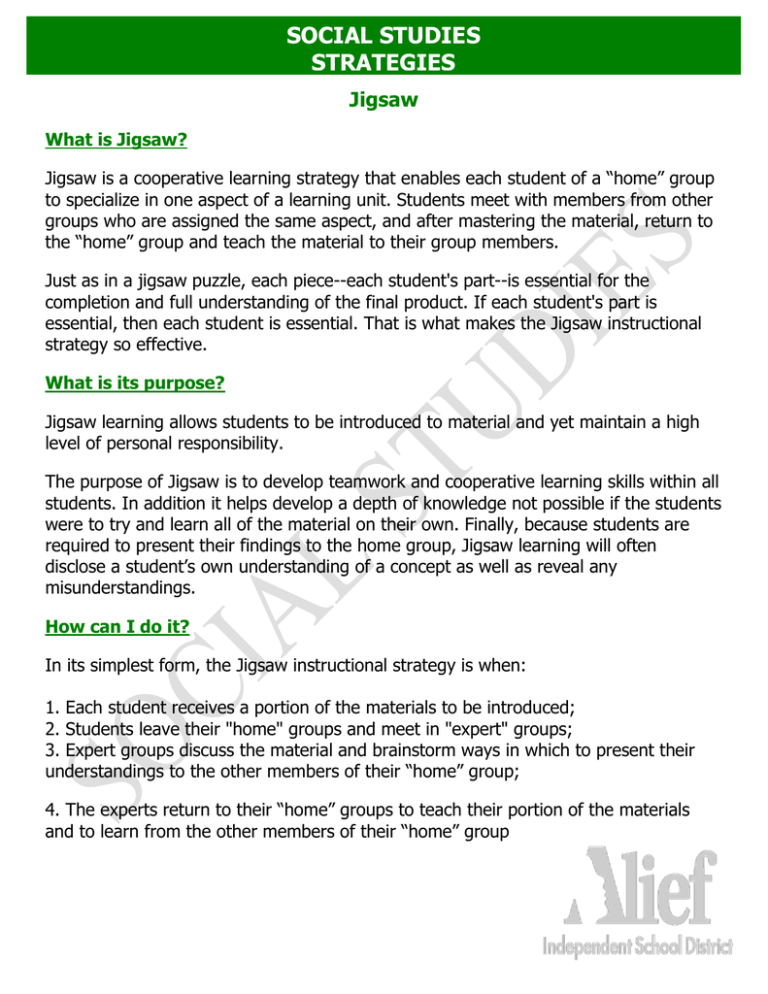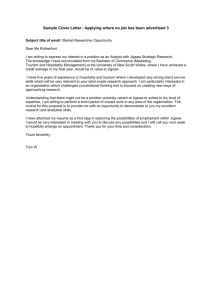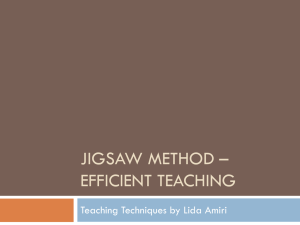SOCIAL STUDIES STRATEGIES Jigsaw
advertisement

SOCIAL STUDIES STRATEGIES Jigsaw What is Jigsaw? Jigsaw is a cooperative learning strategy that enables each student of a “home” group to specialize in one aspect of a learning unit. Students meet with members from other groups who are assigned the same aspect, and after mastering the material, return to the “home” group and teach the material to their group members. Just as in a jigsaw puzzle, each piece--each student's part--is essential for the completion and full understanding of the final product. If each student's part is essential, then each student is essential. That is what makes the Jigsaw instructional strategy so effective. What is its purpose? Jigsaw learning allows students to be introduced to material and yet maintain a high level of personal responsibility. The purpose of Jigsaw is to develop teamwork and cooperative learning skills within all students. In addition it helps develop a depth of knowledge not possible if the students were to try and learn all of the material on their own. Finally, because students are required to present their findings to the home group, Jigsaw learning will often disclose a student’s own understanding of a concept as well as reveal any misunderstandings. How can I do it? In its simplest form, the Jigsaw instructional strategy is when: 1. Each student receives a portion of the materials to be introduced; 2. Students leave their "home" groups and meet in "expert" groups; 3. Expert groups discuss the material and brainstorm ways in which to present their understandings to the other members of their “home” group; 4. The experts return to their “home” groups to teach their portion of the materials and to learn from the other members of their “home” group In more detail, and written from a teacher’s perspective, to conduct a Jigsaw in your classroom: 1. Assign students to “home” teams of 4 or 5 students (generally their regular cooperative learning teams). Have students number off within their teams. 2. Assign study topics to “home” team members by giving them an assignment sheet or by listing their numbers and corresponding roles on the board. 3. Have students move to “expert” groups where everyone in the group has the same topic as themselves. 4. Students work with members of their “expert” group to read about and/or research their topic. They prepare a short presentation and decide how they will teach their topic to their “home” team. You may want students to prepare mini-posters while in their “expert” Groups. These posters can contain important facts, information, and diagrams related to the study topic. 5. Students return to their “home” teams and take turns teaching their team members the material. I find it helpful to have team members take notes or record the information in their journals in some way. You may want them to complete a graphic organizer or chart with the new information. 6. Involve the class in a whole-group review of all the content you expect them to master on the assessment. Administer an individual assessment to arrive at individual grades. Assessment & Evaluation Considerations Assess students' degree of mastery of all the material. Reward the groups whose members all reach the preset criterion of excellence or give bonus points on their individual scores if these criteria are met. Students will need to evaluate themselves on how well their group did in the jigsaw (e.g., active listening, checking each other for understanding, and encouraging each other) and set goals for further interaction




